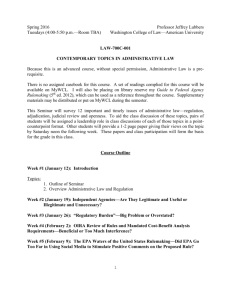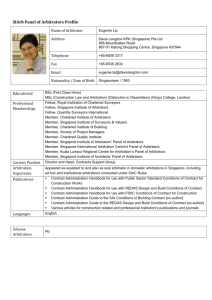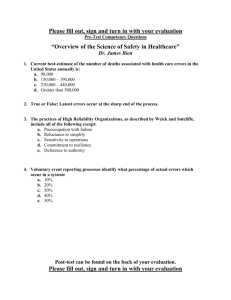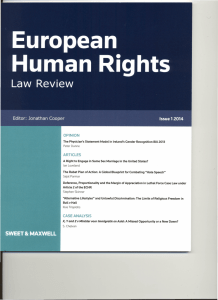Michael Lynk - Queen's University
advertisement
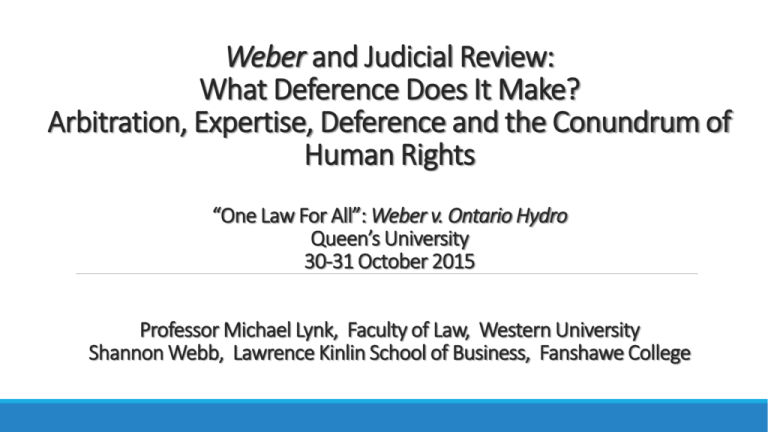
Weber and Judicial Review: What Deference Does It Make? Arbitration, Expertise, Deference and the Conundrum of Human Rights “One Law For All”: Weber v. Ontario Hydro Queen’s University 30-31 October 2015 Professor Michael Lynk, Faculty of Law, Western University Shannon Webb, Lawrence Kinlin School of Business, Fanshawe College Conundrum - What degree of judicial deference for labour arbitrators deciding human rights issues? - Weber contributed to the deference issue because of SCC endorsement of expanded arbitral jurisprudence. But other factors in 1990s as well: ◦ Statutory grant of human rights jurisdiction to arbitrators: i.e.: Section 48(12)(j) of OLRA ◦ Frequency of no-discrimination clauses in collective agreements ◦ Human rights law had/has strong workplace law nexus - Difficulties at human rights commissions/tribunals -Ongoing difficulty: No clear direction from SCC, and confusion in the lower courts Labour Arbitration, Human Rights & Deference - Before Weber: McLeod v. Egan (SCC, 1975), St. Anne Nackawic (SCC, 1986) + Douglas College (SCC, 1990) – on arbitral jurisdiction - Before Weber: Chambly (SCC, 1992) + Mossop (SCC, 1992) + Berg (1993) – on deference & human rights - Question: Are human rights so central to the rule of law in Canada that tribunals can never expect deference, or has human rights expertise been sufficiently acquired by arbitrators such that deference is due? Four SCC Milestone Rulings on Arbitration and Deference (1 of 4) Weber (1995): McLachlin J: “…the appellant Weber argues that jurisdiction over torts and Charter claims should not be conferred on arbitrators because they lack expertise on the legal questions such claims raise. The answer to this concern is that arbitrators are subject to judicial review. Within the parameters of that review, their errors may be corrected by the courts. The procedural inconvenience of an occasional application for judicial review is outweighed by the advantages of having a single tribunal deciding all issues arising from the dispute in the first place.” ………… “[The exclusive jurisdiction model] conforms to a pattern of growing judicial deference for the arbitration and grievance process and correlative restrictions on the rights of parties to proceed with parallel or overlapping litigation in the courts.” Four SCC Milestone Rulings on Arbitration and Deference (2 of 4) Parry Sound (2003) Iacobucci J. “A countervailing consideration is the fact that the Human Rights Commission has greater expertise than grievance arbitrators in the resolution of human rights violations. In my view, any concerns in respect of this matter are outweighed by the significant benefits associated with the availability of an accessible and informal forum for the prompt resolution of allegations of human rights violations in the workplace... “ “Moreover, expertise is not static, but, rather, is something that develops as a tribunal grapples with issues on a repeated basis…” “For the foregoing reasons, the Board was correct to conclude that the substantive rights and obligations of the Human Rights Code are incorporated into each collective agreement over which an arbitrator has jurisdiction …Accordingly, there is no reason to interfere with the Board’s finding that the subject matter of Ms. O’Brien’s grievance is arbitrable. The Board’s finding that the discriminatory discharge of a probationary employee is arbitrable is not patently unreasonable.” Four SCC Milestone Rulings on Arbitration and Deference (2 of 4) Parry Sound (2003) Iacobucci J. “Moreover, expertise is not static, but, rather, is something that develops as a tribunal grapples with issues on a repeated basis…” “For the foregoing reasons, the Board was correct to conclude that the substantive rights and obligations of the Human Rights Code are incorporated into each collective agreement over which an arbitrator has jurisdiction …Accordingly, there is no reason to interfere with the Board’s finding that the subject matter of Ms. O’Brien’s grievance is arbitrable. The Board’s finding that the discriminatory discharge of a probationary employee is arbitrable is not patently unreasonable.” Four SCC Milestone Rulings on Arbitration and Deference (3 of 4) Dunsmuir (2008) Bastarache & LeBel JJ. “In judicial review, reasonableness is concerned mostly with the existence of justification, transparency and intelligibility within the decision-making process. But it is also concerned with whether the decision falls within a range of possible, acceptable outcomes which are defensible in respect of the facts and law.” [47] Four SCC Milestone Rulings on Arbitration and Deference (3 of 4 cont’d) Dunsmuir (2008) Bastarache & LeBel JJ. “Deference will usually result where a tribunal is interpreting its own statute or statutes closely connected to its function, with which it will have particularity familiarity…Adjudication in labour law remains a good example of the relevance of this approach.” [54] “A question of law that is of ‘central importance to the legal system…and outside the…specialized area of expertise’ of the administrative decision maker will always attract a correctness standard… On the other hand, a question of law that does not rise to this level may be compatible with a reasonableness standard…” [55] Four SCC Milestone Rulings on Arbitration and Deference (3 of 4 cont’d) Binnie J. (Minority concurring): “It is sometimes said by judges that an administrator acting within his or her discretion ‘has the right to be wrong’. This reflects an unduly court-centred view of the universe. A disagreement between the court and an administrator does not necessarily mean that the administrator is wrong.”[125] “Labour arbitrators, as in this case, command deference on legal matters within their enabling statute or on legal matters intimately connected thereto. “ [147] Four SCC Milestone Rulings on Arbitration and Deference (4 of 4) Irving Pulp and Paper (2013) Framed as primarily a privacy case NBQB: Quashed arbitration award as unreasonable NBCA: Upheld NBQB – correctness on arbitrator’s analytical framework, + reasonableness on facts Four SCC Milestone Rulings on Arbitration and Deference (4 of 4) Irving Pulp and Paper (2013) Abella J. “…the Court of Appeal erred in disregarding this Court’s direction that decisions of labour arbitrators be reviewed for reasonableness and that deference be paid to their legal and factual findings when there are interpreting collective agreements.” “The board’s decision should be approached as an organic whole, without a line-by-line treasure hunt for error…In the absence of finding that the decision, based on the record, is outside the range of reasonable outcomes, the decision should not be disturbed. In this case, the board’s conclusion was reasonable and ought not to have been disturbed by the reviewing courts.” [54] Policy Considerations 1. Rule of Law Objection - Human rights law is ‘quasi-constitutional’, and is of central importance to legal system - The courts are the only guardians of human rights - A deference standard higher than correctness leads to potential inconsistency in interpreting human rights But - Privacy is also ‘quasi-constitutional’, and now judged on reasonableness (Irving Pulp + Paper) - Fundamental legal questions different from constitutional questions; depends on expertise Policy Considerations 2. Labour Arbitrators Lack Expertise in Human Rights - Common argument in the 1990s - Arbitrators focused on “narrowly restricted field” (LaForest J. in Mossop) - Human rights tribunals more expert than arbitrators, and they are subject to correctness But - Large volume of arbitral decisions on human rights - Specific assignment of human rights jurisdiction by legislatures - Specific assignment of human rights jurisdiction by consensual industrial relations parties in CAs Table 1: Case Sample Pre-Dunsmuir and Post-Dunsmuir Issues Pre-Dunsmuir Number of Cases 11 Total Number of Issues 15 Post-Dunsmuir 36 38 Table 2: Labour Arbitrations Decisions Upheld Decision Upheld (Cases) Decision Upheld (Issues) Pre-Dunsmuir Percentage PostDunsmuir Percentage 7/11 63.6% 28/36 77.8% 9/15 60% 30/38 78.9% Table 3: Standard Examined (PreDunsmuir and Post-Dunsmuir) Correctness Reasonableness Patent Unreasonableness Unstated/Unclear Total Pre-Dunsmuir Issues 7 6 2 Post-Dunsmuir Issues 15 2 38 8 28 - Table 4: Pre-Dunsmuir Employer and Union Success (Issues) Correctness Reasonableness/ Patent Unreasonableness Total Successful % Successful Employer Union Applications Applications 2/3 66.7% 2/4 % 50% Total % Successful Applications 4/7 57.1% 1/4 25% 1/4 25% 2/8 25% 3/7 42.9% 3/8 37.5% 6/15 40% Table 5: Post-Dunsmuir Employer and Union Success (Issues) Correctness Successful Employer Applications 1/3 Reasonableness % % Total % 33.3% Successful Union Applications 1/5 20% 2/8 20% 6/15 40% 3/13 23.1% 9/28 32.1% Unstated 1/1 100% 0/1 0% 1/2 50% Total 8/19 42.1% 4/19 21.1% 12/38 31.5% Case Examples: Pre-Dunsmuir (Correctness) Hamilton Police Ass’n v Hamilton Police Services Board (2005, Ont. Div. Ct.) - “With respect to the issue of expertise, the Supreme Court of Canada has held that the standard of review of labour arbitrators’ decisions interpreting and applying collective agreements is either reasonableness simpliciter (Voice Construction Ltd. (2004, SCC) or patently unreasonableness (Newfoundland Association of Public Employees (1996, SCC). However, an arbitrator’s decision in relation to questions of general law and the interpretation of human rights legislation is subject to a standard of correctness, given that the arbitrator has no greater expertise in this regard than the courts (NAPE, supra at para. 14).” [20] Case Examples: Pre-Dunsmuir (Correctness) Hamilton Police Ass’n v Hamilton Police Services Board (2005, Ont. Div. Ct.) - “Ultimately, the question of the standard of review in this case turns on the issue that the arbitrator was determining…As in the NAPE case above, the arbitrator was required to be correct in his legal interpretation of the duty to accommodate, but his decision applying that duty to the facts of the case warrants some deference and is subject to review on a standard of reasonableness.” [23] Case Examples: Post-Dunsmuir (Correctness) Lethbridge Regional Police Service v Lethbridge Police Association (2013 Alberta CA) - “Labour arbitrators are sometimes required to consider human rights and discrimination issues, and in this case the human rights issues were specifically referred to the arbitrator…Where a number of tribunals have concurrent jurisdiction over an issue, consistency requires that review be for correctness: Rogers Communications (SCC, 2012)… Likewise, the nature of human rights issues are that they are questions of law of general importance to the legal system. In the circumstances, the appropriate standard of review is correctness (even when such issues are decided by human rights panels): Irving Pulp & Paper Ltd. v Communications Energy and Paperworkers Union …However, the underlying factual findings of the arbitrator are still entitled to deference.” [28] Case Example: Post-Dunsmuir Reasonableness County of Brant v OPSEU (2013, Ont. Div. Ct.) - “No issue of jurisdiction or procedural fairness is raised. The parties submit, and I agree, that the applicable standard of review is reasonableness. This standard requires deference to findings of fact made by the Arbitrator and to the Arbitrator’s interpretation of the provisions of the Collective Agreement. Further, labour arbitrators have particular expertise in applying human rights principles to issues in the workplace and their conclusions on such issues are therefore entitled to deference.” [29] Questions & Comments Table 4: Upheld Issues (Pre and PostDunsmuir) Pre-Dunsmuir Pre-Dunsmuir Percentages Correctness Reasonableness/ Patent Unreasonableness Unstated/Unclear Total PostDunsmuir Post-Dunsmuir Percentages 4/7 5/8 57.1% 62.5% 7/8 22/28 87.5% 78.6% 7/15 46.7% 1/2 30/38 50% 78.9%



